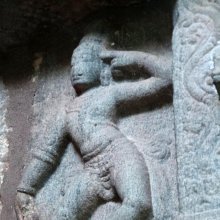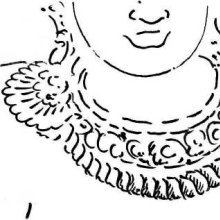Ear: 2 definitions
Introduction:
Ear means something in Hinduism, Sanskrit. If you want to know the exact meaning, history, etymology or English translation of this term then check out the descriptions on this page. Add your comment or reference to a book if you want to contribute to this summary article.
Images (photo gallery)
(+66 more images available)
In Hinduism
Shilpashastra (iconography)
Source: Shodhganga: Elements of Art and Architecture in the Trtiyakhanda of the Visnudharmottarapurana (shilpa)The Ears are denoted by the Sanskrit term Karṇa, and represents one of the various body parts whose Measurements should follow the principles of ancient Indian Painting (citra), according to the Viṣṇudharmottarapurāṇa, an ancient Sanskrit text which (being encyclopedic in nature) deals with a variety of cultural topics such as arts, architecture, music, grammar and astronomy.—In the third part of the Viṣṇudharmottarapurāṇa, chapters 35th to 43rd are dedicated to the Painting of different portraits of different kinds of men and women. The measurement of almost all the body parts that should be maintained in a picture have been presented here. For example, the Ear (karṇa) should be 12 aṅgulas.

Shilpashastra (शिल्पशास्त्र, śilpaśāstra) represents the ancient Indian science (shastra) of creative arts (shilpa) such as sculpture, iconography and painting. Closely related to Vastushastra (architecture), they often share the same literature.
Yoga (school of philosophy)
Source: ORA: Amanaska (king of all yogas): A Critical Edition and Annotated Translation by Jason BirchThe Ear can be denoted by the Sanskrit term Karṇa, according to the Amanaska Yoga treatise dealing with meditation, absorption, yogic powers and liberation.—Accordingly, as Īśvara says to Vāmadeva: “[...] [Now], I shall define the nature of that highest, mind-free absorption which arises for those devoted to constant practice. [...] By means of an absorption for a period of four Palas, [this following] experience may occur: suddenly, an agreeable or disagreeable sound enters the ear (karṇa). [...]”.

Yoga is originally considered a branch of Hindu philosophy (astika), but both ancient and modern Yoga combine the physical, mental and spiritual. Yoga teaches various physical techniques also known as āsanas (postures), used for various purposes (eg., meditation, contemplation, relaxation).
See also (Relevant definitions)
Starts with (+4): Ear-pod wattle, Eared cassia, Eared milkweed, Earghatta yelae balli, Earliest Mahayana-sutras, Early black wattle, Early bunchgrass, Early goldenrod, Early meadow-rue, Early Schools, Earpod wattle, Earpod-tree, Earring, Earring plant, Earth, Earth Element, Earth pea, Earth-apple, Earth-nut, Earth-silkworm betony.
Ends with (+42): African pear, Alligator pear, Anchovy pear, Avocado pear, Balsam pear, Bear, Blind pricklypear, Brittle prickly pear, Buddhist New Year, Cardinal spear, Cardona pear, Cochinchina balsam pear, Coffee hard pear, Common pear, Common prickly pear, Disappearance, Egossa red pear, Elephant ear, Engelmann prickly pear, Erect prickly pear.
Full-text (+2909): Karna, Kundala, Shrotra, Karnavedha, Karnapura, Karnamula, Utkarna, Karnashula, Karnika, Kanisha, Tatanka, Shravana, Karnin, Karnashrava, Avindha, Akarna, Stabdhakarna, Karnandu, Sota, Karnatala.
Relevant text
Search found 424 books and stories containing Ear; (plurals include: Ears). You can also click to the full overview containing English textual excerpts. Below are direct links for the most relevant articles:
The Garuda Purana (by Manmatha Nath Dutt)
Chapter CLXIX - The Nidanam of diseases of the ears < [Dhanvantari Samhita]
Chapter CXCIX - Various other medicinal Recipes < [Dhanvantari Samhita]
Chapter CCXVII - Various Recipes for the cure of sterility, virile impotency, etc. < [Dhanvantari Samhita]
Pallava period (Social and Cultural History) (by S. Krishnamurthy)
Ear Ornaments (Karnabhushana) < [Chapter 4 - Material Culture of the People]
The cultural life of the Pre-Pallava Period < [Chapter 4 - Material Culture of the People]
Conclusion (Material Culture) < [Chapter 5 - Conclusion]
Garga Samhita (English) (by Danavir Goswami)
Verse 3.8.6 < [Chapter 8 - The Opulences of Śrī Girirāja]
Verse 5.7.39 < [Chapter 7 - The Killing of Kuvalayāpīḍa]
Verse 8.13.138 < [Chapter 13 - A Thousand Names of Lord Balarāma]
Kena Upanishad with Shankara’s Commentary (by S. Sitarama Sastri)
Sushruta Samhita, volume 1: Sutrasthana (by Kaviraj Kunja Lal Bhishagratna)
Chapter XVI - Puncturing and Bandaging the ear
Chapter XXXV - Examination of the patient
Manusmriti with the Commentary of Medhatithi (by Ganganatha Jha)
Verse 4.102 < [Section XIII - Days unfit for Study]
Verse 8.234 < [Section XXXIX - Disputes between Owner and Keeper]
Verse 4.36 < [Section IX - Personal Cleanliness]
Related products
(+5 more products available)











